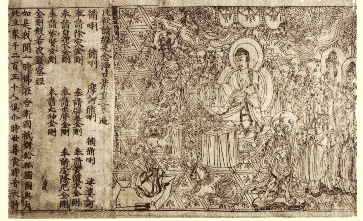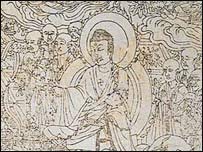
The Diamond Sutra is a short Mahayana sutra of the Perfection of Wisdom genre, which teaches the practice of the avoidance of abiding in extremes of mental attachment. A copy of the Diamond Sutra, found among the Dunhuang manuscripts in the early 20th century, is the oldest known printed book, with a date of 868.
Other names for the ‘Diamond Sutra’ are (Sanskrit: वज्रच्छेदिका प्रज्ञापारमितासूत्र Vajracchedikā-prajñāpāramitā-sūtra; Chinese: 金剛般若波羅蜜多經 or short 金剛經, pinyin: jīngāng bōrě bōluómìduō jīng or jīngāng jīng; Japanese: kongou hannya haramita kyou or short kongou kyou; Korean: 금강반야바라밀경 (金剛般若波羅蜜經), or 금강경 (金剛經) for short; Vietnamese Kim cương bát-nhã-ba-la-mật-đa kinh or Kim cương kinh; Tibetan (Wylie): ’Phags pa shes rab kyi pha rol tu phyin pa rdo rje gcod pa zhes bya ba theg pa chen po’i mdo; “The Sutra of the Perfection of Wisdom of the Diamond that Cuts Through Illusion”)
Contents
The Diamond Sutra, like many sutras, begins with the famous phrase “Thus have I heard” (एवं मया श्रुतम्, evaṃ mayā śrutam). In the sutra the Buddha has finished his daily walk with the monks to gather offerings of food and sits down to rest. One of the more senior monks, Subhuti, comes forth and asks the Buddha a question.
What follows is an often repetitive dialogue regarding the nature of perception. The Buddha often uses paradoxical phrases like “What is called the highest teaching is not the highest teaching”. The Buddha is trying to help Subhuti unlearn his preconceived, limited notions of the nature of reality, enlightenment, and compassion.
At one notable point the Buddha teaches Subhuti that what makes a Bodhisattva so great is that the Bodhisattva does not take pride in his work to save others, nor is his compassion calculated or contrived. The Bodhisattva practices sincere compassion that comes from deep within, without any sense of ego or gain.
In another section, Subhuti expresses concern that the Diamond Sutra will be forgotten 500 years after it is taught (or, alternatively, during the last 500 years of this era). The Buddha assures Subhuti that well after he is gone there will be some who can grasp the meaning of the Diamond Sutra and put it into practice. This section seems to reflect a concern found in other Buddhist texts that the teachings of the Buddha would eventually fade and become corrupted. A popular Buddhist concept, known as mappo in Japanese, also reflects this anxiety.

In Practice
Since it can be read in approximately forty minutes, the Diamond Sutra is often memorized and chanted in Buddhist monasteries. This sutra has retained significant popularity in the Mahāyāna Buddhist tradition for over a millennium, especially in East Asia, and most importantly within the East Asian meditation tradition (Zen and related disciplines), where it is extensively recited, taught, and commented upon even today. The text resonates with a core aspect of Zen, the theme of non-abiding.
It is repeatedly stated in the Diamond Sutra that if a person embodies even four lines of the sutra within their sadhana (spiritual practice), they will be blessed.
Toward the end of the sutra is a gatha which may be translated (borrowing to some extent from both Thich Nhat Hanh and Mu Soeng) as follows: “Thus should one view all of the fleeting world – a drop of dew, a bubble in a stream, a flash of lightning in a summer cloud, a star at dawn, a phantom, and a dream.”
As the earliest printed book
There is a wood block printed copy in the British Library which, although not the earliest example of block printing, is the earliest example which bears an actual date. The copy is a scroll, about 16 feet long, purchased 1907 by the archaeologist Sir Marc Aurel Stein in the walled-up Mogao Caves near Dunhuang, in northwest China from a monk who was guarding the caves known as the “Caves of the Thousand Buddhas.” The colophon, at the inner end, reads: “Reverently made [caused to be] for universal free distribution by Wang Jie on behalf of his two parents on the 13th of the 4th moon of the 9th year of Xiantong [11 May 868]”. This is about 587 years before the Gutenberg Bible.
– Source: Diamond Sutra




